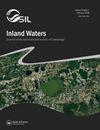Hybrid three-dimensional modelling for reservoir fluorescent dissolved organic matter risk assessment
IF 2.3
3区 环境科学与生态学
Q1 LIMNOLOGY
引用次数: 1
Abstract
ABSTRACT A coupled data-driven and 3-dimensional (3D) process-based fluorescent dissolved organic matter (fDOM) prediction model was developed for a shallow, subtropical Australian reservoir. The extent to which reservoir water volume, inflow, and wind conditions affect the fDOM transport dynamics during cyclonic weather events was assessed through scenario analysis and a data-driven Bayesian network (BN) approach. The analysis shows that (a) inflow plumes are the main sources of fDOM during heavy rainfall; (b) the concentration of fDOM near the dam wall is related to rainfall intensity; (c) higher reservoir volumes reduce the rate of increase and peak of fDOM concentration during rainfall events; and (d) fDOM transport to the dam wall is strongly influenced by the prevailing wind direction. A naïve BN developed for fDOM assessment displayed a strong sensitivity of the peak fDOM value to rainfall-related characteristics while the lag time between rainfall event and fDOM peak at the dam wall was highly sensitive to reservoir water volume and wind speed. The hybrid modelling approach provides both new information on 3D fDOM transport in reservoirs during extreme weather events through the model application and an easy-to-interpret, instantaneous modelling output for treatment operators through the BN modelling component. The BN modelling is an essential addition for water treatment operators to promptly predict the impacts of extreme weather events and proactively adjust treatment operations without the computational time burden of a 3D process-based model.储层荧光溶解有机物风险评估的混合三维模型
摘要针对澳大利亚浅层亚热带油藏,建立了一个数据驱动和基于三维(3D)过程的荧光溶解有机物(fDOM)耦合预测模型。通过情景分析和数据驱动的贝叶斯网络(BN)方法评估了气旋天气事件期间水库水量、入流和风况对fDOM传输动力学的影响程度。分析表明:(a)入流羽流是强降雨过程中fDOM的主要来源;(b) fDOM在坝墙附近的浓度与降雨强度有关;(c) 较高的水库容量降低了降雨事件期间fDOM浓度的增加速率和峰值;以及(d)fDOM向坝墙的传输受到主导风向的强烈影响。为fDOM评估开发的天真BN显示出fDOM峰值对降雨相关特征的高度敏感性,而降雨事件与坝墙fDOM峰值之间的滞后时间对水库水量和风速高度敏感。混合建模方法通过模型应用程序提供了关于极端天气事件期间水库中三维fDOM传输的新信息,并通过BN建模组件为处理操作员提供了易于解释的即时建模输出。BN建模是水处理操作员快速预测极端天气事件影响和主动调整处理操作的重要补充,而无需基于3D过程的模型的计算时间负担。
本文章由计算机程序翻译,如有差异,请以英文原文为准。
求助全文
约1分钟内获得全文
求助全文
来源期刊

Inland Waters
LIMNOLOGY-MARINE & FRESHWATER BIOLOGY
CiteScore
6.10
自引率
9.70%
发文量
34
审稿时长
>12 weeks
期刊介绍:
Inland Waters is the peer-reviewed, scholarly outlet for original papers that advance science within the framework of the International Society of Limnology (SIL). The journal promotes understanding of inland aquatic ecosystems and their management. Subject matter parallels the content of SIL Congresses, and submissions based on presentations are encouraged.
All aspects of physical, chemical, and biological limnology are appropriate, as are papers on applied and regional limnology. The journal also aims to publish articles resulting from plenary lectures presented at SIL Congresses and occasional synthesis articles, as well as issues dedicated to a particular theme, specific water body, or aquatic ecosystem in a geographical area. Publication in the journal is not restricted to SIL members.
 求助内容:
求助内容: 应助结果提醒方式:
应助结果提醒方式:


